

Tucked away in the hills above the San Fernando and Simi valleys was a 2,800-acre laboratory with a mission that was a mystery to the thousands of people who lived in its shadow. In a place called Area IV of the Santa Susana Field Laboratory (SSFL), there was a secret collaboration between the U.S. government and private companies to test the limits of nuclear power.
For decades, scientists and staff at SSFL experimented with new types of nuclear reactors, advanced rocket systems and futuristic weapons. While this research helped launch Americans into space and provided a better understanding of nuclear power, years of mishandling dangerous radioactive materials and chemicals has also left a toxic legacy for generations of people living near the site. The scientists are now gone, but acres and acres of radioactive and chemical contamination remains right above the neighborhoods of thousands.
The NBC4 I-Team spent a year investigating the story of the Santa Susana Field Lab. Our work involved interviews with whistleblowers, an intense review of more than 15,000 pages of government, academic and corporate documents, and interviews with dozens of community members, experts and public officials. We now know these families have been living in the shadow of one of the nation’s worst nuclear disasters in history and for the first time, NBC4 is revealing LA’s Nuclear Secret.
 The Site
The SiteThe Santa Susana Field Lab occupies more than 2,800 acres in the rocky terrain of the Simi Hills at the intersection of Simi Valley and the West San Fernando Valley. It sits atop the Simi Hills overlooking Simi Valley to the north, Chatsworth, West Hills and Canoga Park to the east, Woodland Hills and Thousand Oaks to the south, and Moorpark to the west.
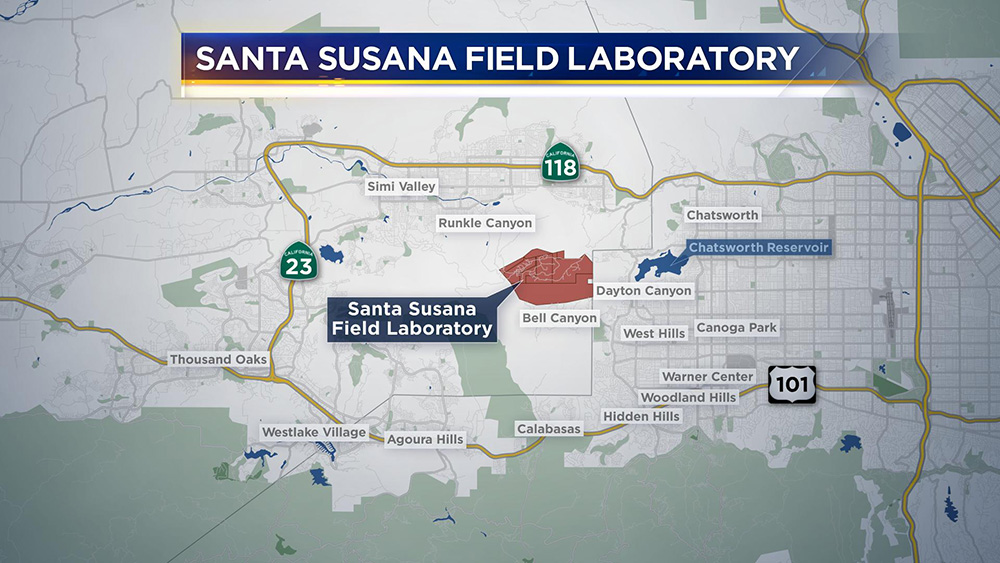
When the site was initially developed by North American Aviation, it was in a remote, but growing part of Los Angeles and Ventura counties. Suburban housing developments were springing up nearby, but cows still roamed freely and local farms grew oranges and other produce.
But things have changed. Today, there are more than a half million people living within 10 miles of the site surrounded by dense suburban populations. Thousands live within two miles of the lab.
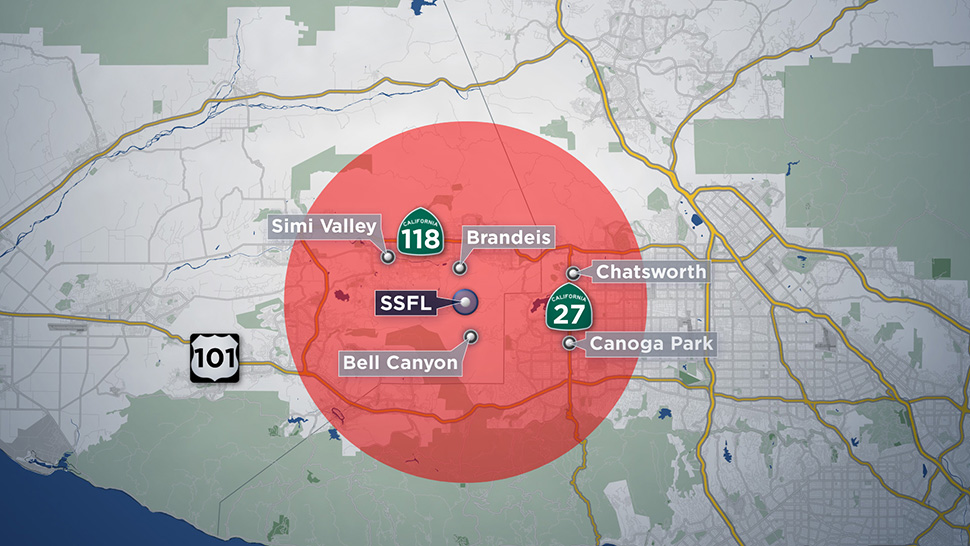
The Santa Susana Field Lab went into operation in 1947 and would eventually become home to 10 experimental nuclear reactors as well as the site of thousands of rocket, energy and weapons tests. Because of corporate mergers and acquisitions over the years, SSFL has had several owners throughout the decades. It’s also been used by the U.S. government. Its nuclear activities at Area IV were once supervised by the U.S. Atomic Energy Commission which later became the United States Department of Energy. Another section of the field lab is actually owned by the federal government and was used by NASA for rocket tests and scientific experiments.
To better understand what went on at the site, it’s important to understand how it operated.
What is the Santa Susana Field Laboratory (SSFL)?
With the detonation of the world’s first nuclear weapon by the United States Army on July 16, 1945, the world ushered in the "Atomic Age." Two years later, an American aerospace company called North American Aviation selected a rural location in the hills above Simi Valley to build a secret research facility. At first, the purpose of the site was to test rocket engines. But in 1953, under the supervision of the U.S. Atomic Energy Commission, the predecessor of the Department of Energy and the Nuclear Regulatory Commission, the Field Lab added Area IV. This 209-acre section of the Field Lab was dedicated to nuclear research including the development and testing of experimental nuclear reactors. Over the course of four decades, Area IV would be home to 10 reactors, a plutonium fuel fabrication facility, a uranium fuel facility and a "hot lab" for remotely cutting up dangerous radioactive material. The rest of the site, more than 2,000 acres was used for the testing and development of rocket engines for the U.S. space program and for advanced weapons research. During its operational history, more than 30,000 rocket engine tests were conducted at SSFL.
Why was it called a Field Lab?
According to California Senate Bill 990 (a state law passed IN 2007 to clean-up SSFL), the site was initially intended to be a remote location for doing scientific work that was considered too dangerous to be done around more populated areas. The Santa Susana Field Laboratory Advisory Panel, funded by the California Legislature, reports that while at the Field Lab, scientists had the freedom to experiment, test and in some cases push their equipment to its limits and beyond.
Over the years, the site was used to test new rocket designs and 10 experimental nuclear reactors. The freedom to experiment resulted in a host of technological breakthroughs, including the development of many of the engines that rocketed American astronauts and satellites into space. But according to the Advisory Panel, the experimental nature of the site also created an atmosphere where science sometimes trumped safety and environmental concerns. They say this has now resulted in serious chemical and radioactive contamination throughout the site. Studies by the DOE and EPA have determined that significant chemical and radioactive contamination can still be found on the site today.
Where is the Field Lab located?
The Santa Susana Field Lab is more than 2,800 acres atop the Simi Hills overlooking Simi Valley to the north, Chatsworth, West Hills and Canoga Park to the east, Woodland Hills and Thousand Oaks to the south, and Moorpark to the west.
Why did they pick that location for the Field Lab?
North American Aviation wanted a remote site for performing dangerous scientific work that was far from prying eyes and away from populated areas. When the company was looking for a location for the Field Lab, they evaluated six potential locations around Southern California. The company looked at safety factors such as weather challenges, possible water contamination and the distance to residential communities. Santa Susana ranked fifth out of the six sites because its weather patterns increased the risk of contaminated air and water flowing off-site. Despite these concerns, the company selected the Santa Susana location for the Field Lab. The site was ultimately chosen because of its proximity to local research universities where many of the Field Lab scientists also worked and taught, according to a 2006 California State report on the Field Lab.
How is the Santa Susana Field Lab organized?
The Santa Susana Field Lab is divided into four areas. Areas I through II were used primarily for rocket testing, missile testing and munitions development. A small section of Area I and the 409 acres of Area II are owned by the U.S. government and used by NASA for rocket testing. Area IV was used primarily for nuclear reactor development, experimentation and testing. While the land for Area IV has been owned by various aerospace companies over the years, the U.S. government has leased and overseen most of the nuclear research that occurred at this part of the site. Although the Field Lab was divided into four areas, some employees worked in multiple areas. In interviews with the Department of Energy and the U.S. EPA, some of these workers say they would frequently move between the areas while working on a variety of projects.
Who owns SSFL?
In 1947, the Santa Susana Field Lab property was acquired by North American Aviation. A few years later, a division of North American Aviation called Atomics International developed Area IV on behalf of the Atomic Energy Commission, the predecessor of the Department of Energy and the Nuclear Regulatory Commission, to test experimental nuclear reactors. In 1955, Rocketdyne was founded as a division of North American Aviation and oversaw operations in Areas I-III at the Santa Susana Field Lab. In 1967, North American Aviation merged with Rockwell Standard to become North American Rockwell. Six years later, the company changed its name to Rockwell International. Rocketdyne remained a division of Rockwell International. Boeing acquired Rocketdyne in 1996 when acquiring the aerospace divisions of Rockwell International and is the current owner of the majority of the SSFL with the exception of Area II which is currently Federal property under the responsibility of NASA. The U.S. Department of Energy also leases a portion of Area IV.
Who is responsible for the clean-up of the Santa Susana Field Lab?
As the current owner of the site, Boeing is responsible for the majority of the clean-up of the Field Lab, which is regulated by the California Department of Toxic Substances Control. NASA is responsible for cleaning up its sections of the site, 41 acres in Area I and 409 acres in Area II. The U.S. Department of Energy has taken responsibility for cleaning up most of Area IV as the nuclear work was done on behalf of the United States government.
What is the status of the clean-up at SSFL?
Over the years, some cleanup work has been done on the site. Many of the buildings have been removed and, according to Boeing, "a substantial amount of contaminated soil."
California Senate Bill 990, signed into law by Gov. Arnold Schwarzenegger in 2007, would have required the responsible parties to clean up the Santa Susana Field Lab to a level suitable for agricultural or residential use, whichever was more stringent. The law, however, was struck down by a federal court after Boeing challenged its validity on the grounds that it singled out one particular site in California for stringent action.
IIn 2010, NASA and the U.S. Department of Energy signed Administrative Orders of Consent (AOC) with the State of California to fully clean up their sections of the Field Lab to background levels. This means any contamination that they created would have to be cleaned up. The California Department of Toxic Substances Control (DTSC), the agency that regulates the site, told NBC4 they will hold the DOE and NASA to those agreements. Boeing did not sign an AOC. Instead, their cleanup is bound by a 2007 State of California Consent Order. This order gives the DTSC authorization to determine the cleanup levels for the Boeing sections of the site. DTSC tells NBC4 that they have not yet determined those levels. Boeing tells NBC4 "the cleanup will be based on established science and follow the regulatory process with transparency and full community participation." Further, the company says that in the future the site will only be used as "undeveloped open space."
According to Dan Hirsch, a nuclear policy instructor at U.C. Santa Cruz who has reviewed Boeing's latest cleanup plan and has been advocating for a full clean-up for decades, Boeing's latest plan would leave the majority of the contamination on the site. And Linda Adams, former Secretary of the CalEPA, tells NBC4 that all of the contamination should be cleaned up. She is concerned that leftover contamination could travel to neighboring communities. DTSC will make the final decision on the cleanup levels.
Timeline
Throughout the years, most of the people who lived near the Lab knew very little about the work being conducted at the location. Only a select few knew its full history of scientific achievements and toxic failures.
HISTORY OF NUCLEAR ACCIDENTS
During its history, there were several nuclear accidents at the Santa Susana Field Lab. Some experts believe the 1959 partial meltdown at SSFL could be the worst nuclear disaster in U.S. history, surpassing the radiation released during the Three Mile Island accident.
Statements
We asked the responsible parties to speak to us on camera and answer our questions. The U.S. Department of Energy, NASA, Boeing and Brandeis-Bardin Institute all declined our requests for an on-camera interview. Instead, they provided us with written statements.
United States Department of Energy
"DOE is committed to the safe cleanup of the Energy Technology Engineering Center and is actively working on groundwater characterization having already completed soil characterization. We look forward to continuing to work with the State of California, Congress, the Chumash tribe, and local stakeholders in fulfillment of this important mission."
NASA
"NASA remains committed to meeting its obligations under the 2010 Administrative Order on Consent for remediation of the areas of Santa Susana Field Laboratory under NASA purview and achieving a cleanup that is protective of public health and the environment. We are making progress with demolition of obsolete administrative facilities, soil and groundwater investigations, groundwater monitoring, and treatability studies involving both laboratory and field-testing in preparation for a comprehensive soil cleanup effort.
While decisions about national monument status are outside of NASA’s authority, the agency shares with many in the community a desire to protect cultural and historical resources at Santa Susana. We will defer the demolition of the historic test stands, including those within the Coca Test Area, for as long as deferment does not impact the agency’s overall cleanup responsibilities, while the appropriate offices within the executive branch consider the National Monument proposal."
Boeing
"Boeing has made significant progress investigating, cleaning up and restoring Santa Susana. We have already removed a substantial amount of contaminated soil under the direction of two state agencies. We installed state-of-the-art treatment systems for cleaning groundwater and improving stormwater quality. We are ready to move forward and finish the soil cleanup to fulfill our responsibilities outlined in the 2007 agreement, as soon as the final remedy is selected by the state.
"We remain resolute in our commitment to perform a comprehensive and fully protective cleanup of Santa Susana. The cleanup will be based on established science and follow the regulatory process with transparency and full community participation. We will restrict Boeing’s property so it will never be used for residential, commercial, industrial or agricultural purposes, but the land will be cleaned up so it is safe enough that houses could be built there if it wasn’t restricted. This level of cleanup is about ten times more protective of human health than is required for the site’s future use as undeveloped open space.
"Numerous studies conclude that there is no evidence that past facility operations have affected the health of the local community. In an April 2013 letter to the mayor of Simi Valley, the Department of Toxic Substances Control stated, 'To date we have not found evidence of off-site contamination from SSFL that would pose a risk to human health or the environment.'
"These findings, together with a fully protective cleanup, mean Santa Susana can be safely enjoyed by future generations. Santa Susana sits within a crucial habitat linkage frequented by mountain lions and many other species. It is a site rich in Native American heritage. We want to protect these invaluable natural and cultural resources for the future, which is why we will take the balanced actions necessary to clean up, preserve and protect Santa Susana as undeveloped open space for the benefit of wildlife and enjoyment by people."
Brandeis-Bardin Institute
Below is a statement to NBC4 in response to our report, which mentions that radiation from the Santa Susana Field Lab was found offsite in the soil at the nearby Brandeis-Bardin Institute (BBI), home to Camp Alonim—a summer camp attended by some 30,000 children. In 1993, a US EPA-supervised study found “radioactive elements” in a limited number of soil samples from the Brandeis property. In December 1995, Brandeis-Bardin sued the owner of the field lab at the time (Rocketdyne), alleging that “hazardous materials” from Santa Susana—including radioactive elements--have “seeped into... the soil and groundwater” of Brandeis, and “will cause great and irreparable injury” to its land. In May 1997, Brandeis settled that suit in a confidential agreement with Rocketdyne. A Brandeis spokesman, Rabbi Jay Strear told the I-Team that BBI routinely tests its groundwater and soil and believes “the site is safe.” The I-Team asked BBI to see those soil and water tests, and any recent documentation that the state or federal government has certified the property as “safe,” but BBI declined to share that information with us. Here is BBI’s Statement to NBC4:
There is absolutely no question that the Brandeis-Bardin Institute (BBI) property is safe, and has been for decades, if not longer.
American Jewish University (AJU) acquired the BBI site in 2007 after conducting extensive diligence on the environmental condition of the property, including a comprehensive evaluation of two decades worth of testing by state and federal authorities, and by BBI. Based on an exhaustive records review and the conclusion of scientific experts, we found no cause for concern about the health and safety of the campers, staff or other visitors – past or present. Current testing confirms the safety of the property.
Importantly, the BBI property has never had a validated reading of unsafe contamination levels in water, soil, milk or vegetation. In 1995, the Environmental Protection Agency definitively concluded that there was no health risk to campers or camp counselors on the BBI property. In fact, the risk level to campers or counselors measured less than one in a million.
Continued testing since AJU’s acquisition of the site confirms the ongoing safety of the property. Soils, milk and agriculture on the BBI property are tested on a periodic basis, and groundwater is tested multiple times each year, all supervised by the California Department of Toxic Substances Control. These results have consistently shown the site to be safe.
Since 1964, 100 percent of the site’s drinking water has come from the Calleguas Municipal Water District, which provides water to roughly three-quarters of Ventura County residents. Further, AJU has no evidence that drinking water used prior to that time came from well water on the property. In any case, the BBI property has never had a validated reading of unsafe contamination levels in water.
AJU remains committed to the health and well-being of all campers, staff and visitors at BBI. We are proud of the long-standing track record of safety and the ongoing commitment to testing to ensure a safe and healthy environment for everyone who visits.
Runkle Canyon LLC
"Under no circumstances would we have ever built on this land if it posed potential health issues for our homeowners and neighbors. That is why, before starting construction at Runkle Canyon, we followed rigorous testing protocols and received approval from the California DTSC. Furthermore, testing by the U.S. EPA has shown that Runkle Canyon soil is no different than soil tested at other areas throughout Greater Los Angeles. It is irresponsible for KNBC to frighten viewers by relying on old research using outdated methodologies while ignoring verifiable scientific findings which show that Runkle Canyon is safe for residential development."
 The Whistleblowers
The WhistleblowersFor decades, two former Santa Susana employees lived with the secrets that they witnessed at the site. John Pace was working at the Sodium Reactor Experiment in 1959 when it experienced a partial meltdown. His account of what happened, supported by documents obtained by NBC4’s I-Team and interviews with government officials, experts and academics, varies greatly from the official accounting of the incident.
While the Atomic Energy Commission, the predecessor of the U.S. Department of Energy, claims that there was “no release of radioactive materials” to the environment, Pace says that dangerous radiation was released for weeks and went which ever direction the wind was blowing. Pace says the large door in the reactor was opened so they could vent the radiation from inside the building. He also remembers that the exhaust stack of the reactor was opened so that radiation could be released from inside the damaged reactor straight into the atmosphere.
For more than three hours, we interviewed John Pace about what happened in 1959. Only a fraction of what he told us ended up in our broadcast stories. Here are some of the other things that Pace had to say:
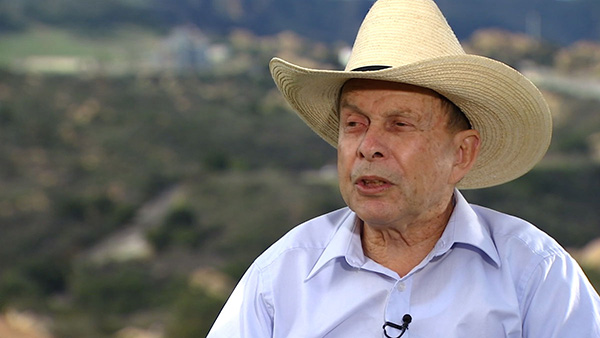
Select a question
Pace also provided us with a timeline of his activities at the Field Lab
Dan Parks worked at the Santa Susana Field Lab in the early 1960s. He was a health physicist and his job was to monitor radiation at the site. During a nearly three-hour interview, Parks told us that he witnessed the release of radioactive materials from several of the site’s nuclear reactors into the environment. He also witnessed the burning of radioactive waste in at the Field Lab’s burn pits. These were manmade lakes where waste was dumped and burned.
Here are some of Dan Park’s observations from his time at the Santa Susana Field Lab.
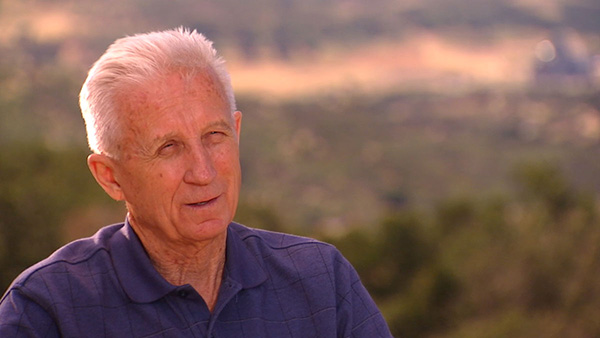
Select a question
 The Community
The CommunityFor decades, people living in neighborhoods around the Santa Susana Field Lab have worried about the impact of the activities at the site on their health. Because the Lab sits on top of a hill, some neighbors we spoke with worry that the contamination isn’t staying on the site. They may have good reason to worry. Experts we spoke with, including a former Secretary of the California EPA, a medical doctor who studies radiation and a top government scientist told us that when the wind blows or the rains come and the water flows downhill from the site, radioactive and chemical contamination can come with it. And several studies, lawsuits and expert opinions raise serious concerns about off-site contamination as a result of what went on at the Santa Susana Field Lab.
Through months of research, the use of social media and old fashioned investigation, the NBC4 I-Team identified dozens of people who believe their health or their family’s health was impacted by the research at the Santa Susana Field Lab. Many of them agreed to sit down with us for a daylong interview. Each shared their opinion on why they believe the Field Lab is to blame for their family’s suffering.
Click on a photo to learn more about each person’s story:
 The Brandeis-Bardin Institute
The Brandeis-Bardin InstituteIn 1947, Dr. Shlomo Bardin purchased 2,200 acres of land in the foothills of the Santa Susana Mountains downhill from the Santa Susana Field Lab. Over the next 68 years, the land would become home to The Brandeis-Bardin Institute, a center for Jewish study, learning and culture. Home to Camp Alonim, a sleep-away-camp for kids, the Brandeis Collegiate Institute and numerous events and activities for Jews of all ages, BBI now encompasses 2,800 acres and operates year-round. It is the largest piece of Jewish-owned land outside of Israel. Today, the campus is part of American Jewish University, which owns the Institute.
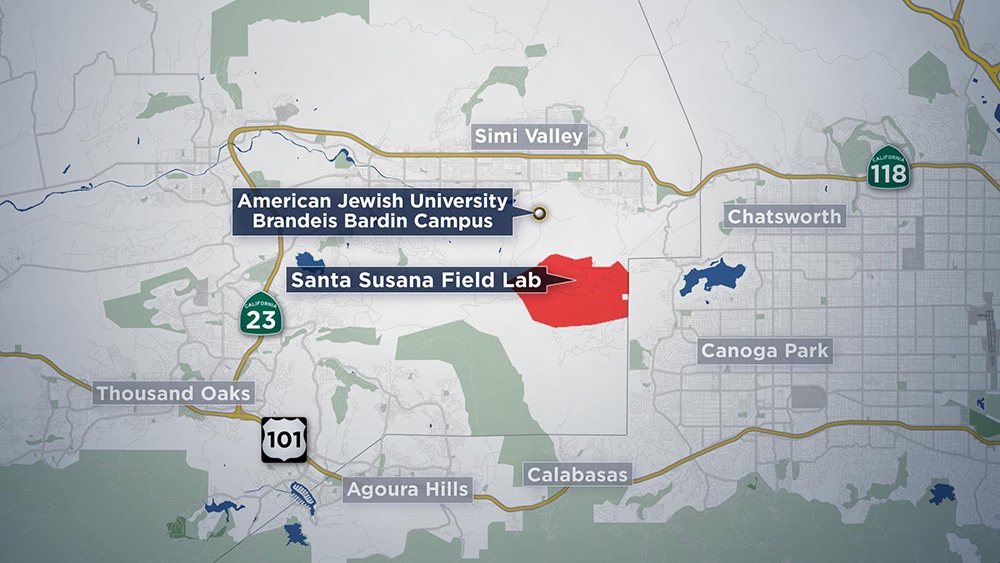
The Brandeis-Bardin Institute came into existence at the same time as the Santa Susana Field Lab was being built. While the employees at the Field Lab performed nuclear research and rocket tests, children and adults were participating in activities just a few miles downhill at Brandeis. In 1993, a U.S. EPA-supervised study found "radioactive elements" in a limited number of soil samples from the Brandeis property. While the EPA said the levels were safe at the time, the National Academies of Sciences now say there is no safe level of radiation.
In December 1995, Brandeis-Bardin sued the owner of the Field Lab at the time (Rocketdyne), alleging that "hazardous materials" from Santa Susana, including radioactive elements, have "seeped into... the soil and groundwater” of Brandeis. In May 1997, Brandeis settled that suit for $3.2 million and agreed never again to sue Boeing (the current owner of the Field Lab). Six years later, the California Department of Toxic Substance Control found the chemical perchlorate, often used in rocket testing, in a well on the Brandeis property at levels exceeding California's drinking water standards.
Timeline
A Brandeis spokesman, Rabbi Jay Strear, told the I-Team that BBI routinely tests its groundwater and soil and believes "the site is safe." NBC4 asked to see all of their environmental tests conducted during the Institute's 68-year history, but were only given tests from 1996, 2006, 2007, 2009, 2011, 2012, 2013 and 2014 that were limited in where and what was tested.
NBC4 has repeatedly asked the American Jewish University (AJU), which took ownership of The Brandeis-Bardin Institute in 2007, for an interview for this story. They declined. Instead, AJU emailed us a 6-page letter, which includes their official response. NBC4 has elected to publish AJU’s entire letter in addition to their official statement. Because they have not provided us with a forum to ask follow-up questions, we have added our responses to their letter. The AJU’s official statement can be found below. For months, NBC4 asked for all soil and water tests ever done on Brandeis property and AJU refused. Several days before our story aired, AJU did provide us with brief memoranda about eight tests but many were missing key elements, such as lab reports. AJU gave us no test data for 13 out of the last 20 years, even though they say their groundwater is tested several times a year.
Documents
These are some of the key documents NBC4 uncovered during our investigation of contamination at The Brandeis-Bardin Institute. You can click on a document to read it for yourself. You can also click on the yellow annotations to learn more about what we found in the documents.
 The Paper Trail
The Paper TrailPiecing together the history of the Santa Susana Field Lab and especially AREA IV, where the nuclear research took place, wasn’t easy. Many of the original documents have been lost, destroyed or withheld. The official version of the 1959 meltdown sought to minimize the impact of the incident and the radioactive releases. Dr. Jan Beyea, who studied the 1959 accident for California’s Santa Susana Field Laboratory Advisory Panel, wrote in a paper that “had there been a large release [of radiation] kept secret at SRE, it would have been consistent with earlier behavior in the United States.” This effort to keep the story secret is what we discovered during our yearlong investigation.
Despite the challenges, the NBC4 I-Team spent months collecting and reviewing more than 15,000 pages of documents. Some of these documents were obtained through government Freedom of Information Act requests, others were provided by whistleblowers and experts who have studied the site. In the end, we performed an intensive review of hundreds of government, corporate, academic and community documents. Through this effort, we were able to piece together LA’s Nuclear Secret.
We invite you to review some of these documents for yourself.
To learn more about how this series came to fruition, we asked the producer of the series to share his journey from the first tip to the completion of the stories.
 THE LEGACY
THE LEGACYWhile our current investigation took us a year, this is actually a story 36 years in the making. In 1979, KNBC was the first station in the country to report on a nuclear accident in Area IV at the Santa Susana Field Lab. At the time, we were told that no radiation had escaped into the community. Over the years, we followed the fight for a clean-up of the site and reported on new developments. This year, we decided to connect-the-dots for the first time and conduct a yearlong investigation into what really happened in Area IV. And 4 the first time, we’ve documented the truth behind LA’s Nuclear Secret.
Here are some of our original 1979 stories featuring the investigative work of reporter Warren Olney and producer Pete Noyes.
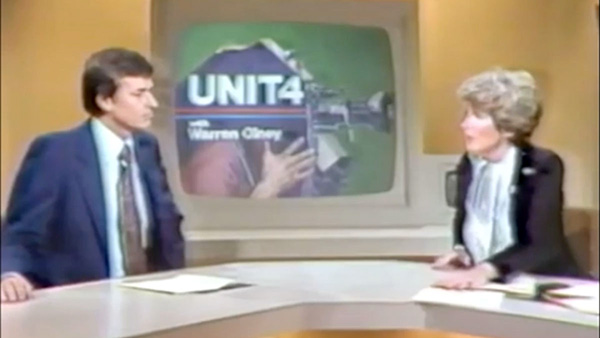
Project credits
Reporters: Joel Grover and Matthew Glasser
Digital Producers: Jonathan Lloyd, Jessica Glazer, Cynthia Andrews
Design and Development: Nelson Hsu
Special thanks to Valley Times Collection/Los Angeles Public Library, ACMELA.ORG, TheAeroSpace.org, Erica Goldman, Atomic Energy Commission
Copyright © 2019 NBC Universal Inc. All rights reserved